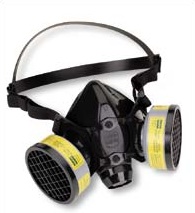
News
Proper fit is key to respiratory safety
December 9, 2010 by Theresa Whalen CFA farm safety consultant
 December 2, 2010 –
December 2, 2010 –
Disposable particulate respirators are being made available free through
provincial farm safety agencies to help farmers plan for safety on their farms.
However, if you wear a respirator improperly, then you might as well have none
at all. So the key message is to think ahead, have a respirator handy, and know
how to use it properly.
December 2, 2010 –
Disposable particulate respirators are being made available free through
provincial farm safety agencies to help farmers plan for safety on their farms.
However, if you wear a respirator improperly, then you might as well have none
at all. So the key message is to think ahead, have a respirator handy, and know
how to use it properly.
The Canadian Federation
of Agriculture has partnered with 3M Canada, Pioneer Hi-Bred Limited and the
Canadian Agricultural Safety Association to offer free N95 particulate
respirators (3M style 9211) across Canada. Look for your free respirator at
trade shows and other events where you meet provincial agricultural and farm
safety organizations. For a list of participating organizations as well as more
information on how to fit test an N95 respirator, visit www.planfarmsafety.ca.
 |
|
Grain dust, moulds,
pollen, animal dander, soil dust, and welding fumes are just a few of many
farm-related respiratory hazards. Exposure can cause immediate and long-term
respiratory illnesses such as farmers’ lung, asthma, emphysema, chronic
bronchitis, and other irreversible, incurable ailments.
When selecting a
respirator, there are several things to consider. Respirators are rated as N
Series, which mean not resistant to oil; R Series, which means resistant to
oil; and P Series, which means oil proof. A mask with an N95 rating is not
resistant to oil and has a 95 per cent filter efficiency rating. Filter
efficiency means the percentage of particulates removed by the filter. There
are three levels of filter efficiency: 95 percent, 99 percent, and 99.97
percent. The higher the efficiency – the lower the leakage.
There are many different
types and sizes of disposable respirators or dust masks available – so be sure
to find one that is comfortable for you. Also ensure you only select a product
with NIOSH or CSA certification. You can expect to pay between $1 and $4 per N
Series respirator – a small investment that will make a big difference in your
long-term health. Respirators should be discarded after one use.
To ensure a proper fit,
a Negative Fit Test should be performed:
- Place the mask over your
mouth and nose, and adjust straps so that the mask fits snugly. - Place your hands over
the respirator so that no air can enter. - Breathe in and hold
your breath. - The mask should suck
in against your face and stay there for 10 seconds after you have stopped
breathing in. - If the mask does not
collapse against your face or immediately releases, re-adjust the straps and
repeat steps 1 through 4. If you cannot maintain a tight seal, try a different
size, make or model of respirator until you find one that does seal. A
respirator may not fit properly if you wear dentures, have facial scarring, are
not clean-shaven, or have had a broken facial bone or facial surgery.
Respirators must be
stored in a clean dry place in a tight container or a sealed plastic bag when
not in use so they are protected from dust, sunlight, extreme heat and cold,
moisture, chemicals and physical damage. Keep respirators in a convenient
location close to where they are to be used.
“Plan • Farm • Safety”
is the three-year theme of the Canadian Agricultural Safety campaign, which was
launched in March. Each aspect of the theme will be promoted over the next
three years.